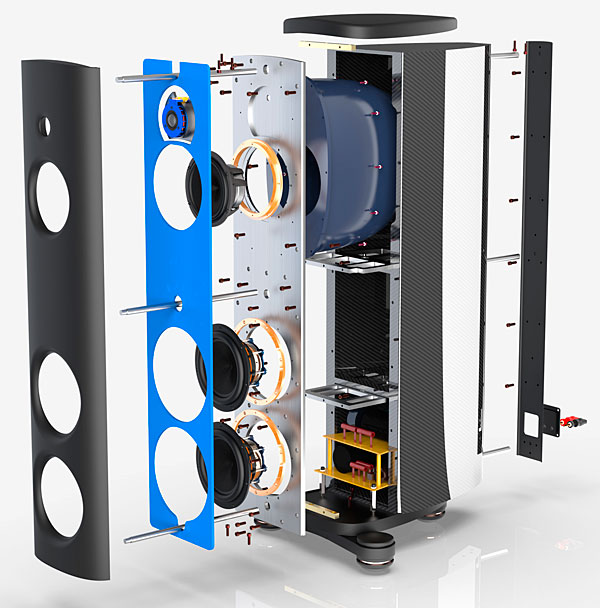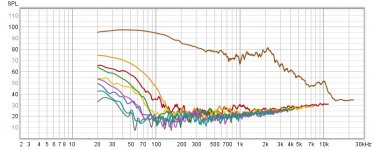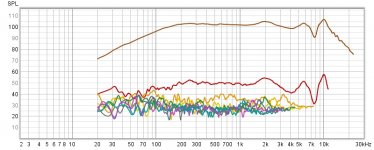I get that, what I'm not understanding fully is why frequencies below 1/2 wavelength are not an issue. Is it purely that they don't cause resonances?
One of the Master Jedi's of loudspeakers once proved that the measured response inside a cabinet is the same as the total power response on the outside of the cabinet. It may seem obvious in hindsight, but he proved it mathematically... I don't remember if it was S. Linkwitz, A.N. Thiele, S. Lipshitz, or someone else.
With all the stuffing and absorption in a modern cabinet, this really only applies below 100 Hz or so... Above that and the stuffing absorption takes over.
I recently used the mic-in-the-box technique to prove to myself that a wierd low frequency null was not a room mode, but was measurement related.
With all the stuffing and absorption in a modern cabinet, this really only applies below 100 Hz or so... Above that and the stuffing absorption takes over.
I recently used the mic-in-the-box technique to prove to myself that a wierd low frequency null was not a room mode, but was measurement related.
Who wants box spatial variations (unless you do)? Not to mention that they can be non-minimum phase.
And not to mention that the box compliance is also part of a resonance 😉
And not to mention that the box compliance is also part of a resonance 😉
I believe it's an approximation of the method to calculate the Schroeder frequency of the room.I get that, what I'm not understanding fully is why frequencies below 1/2 wavelength are not an issue. Is it purely that they don't cause resonances?
Perhaps this is what you mean Jim
"When a speaker driver is mounted in a box it radiates as much energy into the space in front of the cone as it does into the much smaller space behind the cone. What happens to the air borne energy inside? At long wavelengths it is common practice to store it in resonant structures to extend the steady-state low frequency response of the speaker. In general, the energy leads to very high sound pressures inside the box. A small amount of the energy is lost as heat in the stuffing material, some in the process of flexing the cabinet walls. Much of it reappears outside the box, because the thin cone presents a weak sound barrier. Just how much is difficult to measure, but it is a contributor to the frequency response. I am of the opinion that the effect is most notable in the low hundreds of Hz region, where stuffing materials are ineffective and the internal dimensions not small enough for the internal air volume to act as a pure compliance. Consequently, enclosures should be either very small (less than 1/16th of a wavelength) or extremely large, both of which are not very practical for different reasons."
Frontiers
Where does 1/16 wavelength come from?
"When a speaker driver is mounted in a box it radiates as much energy into the space in front of the cone as it does into the much smaller space behind the cone. What happens to the air borne energy inside? At long wavelengths it is common practice to store it in resonant structures to extend the steady-state low frequency response of the speaker. In general, the energy leads to very high sound pressures inside the box. A small amount of the energy is lost as heat in the stuffing material, some in the process of flexing the cabinet walls. Much of it reappears outside the box, because the thin cone presents a weak sound barrier. Just how much is difficult to measure, but it is a contributor to the frequency response. I am of the opinion that the effect is most notable in the low hundreds of Hz region, where stuffing materials are ineffective and the internal dimensions not small enough for the internal air volume to act as a pure compliance. Consequently, enclosures should be either very small (less than 1/16th of a wavelength) or extremely large, both of which are not very practical for different reasons."
Frontiers
Where does 1/16 wavelength come from?
Since my box is stuffed to the brim with high density felt, a much larger amount is lost as heat, to the point that the frequencies above 90hz are less loud in the box than outside the box at the same mic distance from the driver. You can also see here that the lowest half wavelength resonance makes it's appearance at 600hz. The box depth resonance is confused by a vertical brace parallel to the baffle.
Attachments
Last edited:
The above picture represents only one pass through the felt interior(I'm using the shortest sweep, with the mic situated toward the back). Much of what escapes through the driver membrane actually has to make two passes through the felt interior, so the bump we see peaking at 2khz is probably much lower in amplitude by the time it gets back to the driver. Another thing that's creating that peak is the mic being situated exactly between the two sidewalls. The driver cone is also situated exactly between, so it's probably a pretty good representation of what the cone sees when the sound is reflected back
Last edited:
Another strange measurement from inside the cabinet. Look at how harmonics 2 through 8 completely differentiate themselves below 150hz vs outside..
Attachments
Last edited:
are these true sound levels? i can imagine that the sound level within a speaker box can be so loud it easily distorts a cheaper microphone
Calibrated, true sound levels. Also, my umik-1 was factory set for up to 127db. Like I mentioned earlier, above 90hz, it’s actually louder outside of the box at the same mic distance.
Last edited:
I just discovered this. Magico's latest loudspeakers use a CLD baffle construction involving Aluminum and Isodamp, so I don't feel too eccentric now about what I did with my baffles🙂


9:27 in this video shows the machine stamped isodamp after it's set into the baffle recess.
How To Build A Magico Loudspeaker - YouTube
Magico Qpods are made with the same cld concept..
QPod — Magico Loudspeakers
How To Build A Magico Loudspeaker - YouTube
Magico Qpods are made with the same cld concept..
QPod — Magico Loudspeakers
Last edited:
Compared to Sorbothane, the price is similar, but you would have to buy more sq feet.. To make that work, you could get the thinner material and go with double layers.
ISODAMP™ Damping Materials | ISOLOSS™ Vibration Control
ISODAMP™ Damping Materials | ISOLOSS™ Vibration Control
- Home
- Loudspeakers
- Multi-Way
- Midrange experiment with Auto sound panel deadener and high density acoustic felt..


